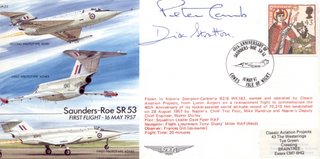Lt Cdr Peter Melville "Sheepy" Lamb DSC*, AFC 1923-2000






A Fleet Air Arm pilot who survived seven wartime prangs at sea to win a DSC and Bar in Korea and Suez. He was the third and last test pilot of the Saunders-Roe SR.53.
In 1941 he went to HMS St Vincent, Gosport, for initial training as a naval airman and then to America for flying instruction at Pensacola, returning as a Midshipman (A) RNVR at the end of 1942. His flying career began inauspiciously when he was delivering a Seafire to Christchurch, Hampshire, in June 1943. He joined 808 squadron, flying Seafires from the escort carrier Battler, to give fighter cover over the Salerno landings in September.
In 1944, Lamb joined 807, flying Seafires from another escort carrier, Hunter, taking part in the landings in the south of France in August and carrying out anti-shipping strikes in the Aegean later in the year.He joined Hunter in 1945 to join the East Indies Fleet in the Indian Ocean, where 807 gave air support to the reoccupation of Rangoon in May and anti-shipping strikes in June. After the war, Lamb applied for a regular RN commission and was appointed an instructor at the School of Naval Air Warfare, HMS Vulture, St Merryn.
Postwar Lamb spent a year at the Empire Test Pilots School and went to Boscombe Down for three years, during which he tested more than 20 different types of aircraft. On becoming Chief test pilot for Saunders Roe, Lamb flew the rocket jet aircraft SR53, designed to be manned at instant readiness on a carrier's catapult, thus cutting the cost of maintaining combat air patrols over the fleet. The first prototype SR53 crashed on take-off at Boscombe Down, killing the pilot John Booth, but Lamb successfully flew the second, achieving British records for height, of 56,000 feet, and speed, of Mach 1.45, before the whole project was cancelled.
When Saunders Roe was absorbed into the Westland Group, Lamb converted to helicopters. He also became involved with Sir Christopher Cockerell's prototype SRN 1 hovercraft, and made the first hovercraft crossing of the Channel on July 25 1959, the 50th anniversary of Bleriot's historic flight.


<< Home